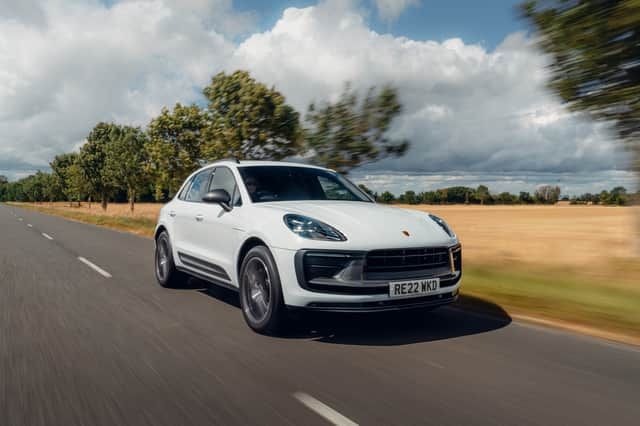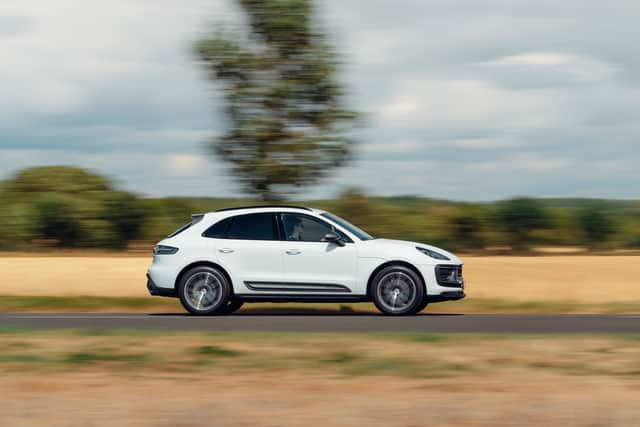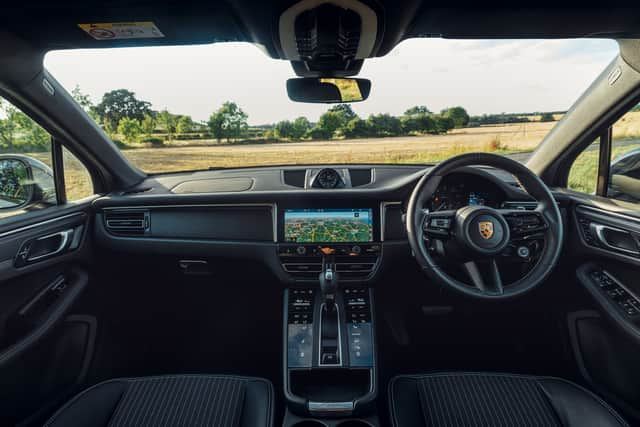Porsche Macan T review: driver-focused SUV with poise and performance


Porsche’s T badge has been around since the 1960s but it was only 12 months ago that the German marque saw fit to apply it to one of its four-door models.
The T stands for Touring and has traditionally been reserved for the more focused versions of cars like the 911. It’s less about shovelfuls of power and more about adding precision and dynamism to already pretty dynamic machinery.
Advertisement
Hide AdAdvertisement
Hide AdIn the case of the Macan that means pairing the entry-level engine with a choice selection of chassis upgrades in order to position the Macan T somewhere between the standard car and the V6-powered Macan S.
As in the base Macan, the T’s 2.0-litre puts out 261bhp and 295lb ft but separating those two, as well as marking the T apart from the S are a number of chassis tweaks designed to give the T more focus than the cars around it.
Truthfully, that four-pot engine is the Macan’s biggest weakness. It’s by no means a bad engine, nor is it lacking in pace - 0-62mph in 6.2 seconds is hardly slow. But, as with most forced-induction four-cylinders, it lacks the verve or the noise of a V6 and the S’s extra 114bhp shaves a whole 1.6 seconds off that 0-62 sprint and costs just £1,000 more.
Of course, that’s only part of the story and lots of SUVs can go quickly in a straight line. What Porsche is promising with the T is a lighter, more agile and more responsive package that makes up for its lesser power with sharper road manners.
Advertisement
Hide AdAdvertisement
Hide AdFor a start, the T sits 15mm lower than its stablemates and is the only model to combine steel springs with Porsche’s PASM adaptive suspension. Spec the optional air suspension and you can go another 10mm lower. The Macan T also gets stiffer anti-roll bars at the front and a retuned chassis setup alongside a new traction control map which delivers a more rear-biased drive.


Porsche also points to the near-60kg weight saving the 2.0-litre offers over the S’s V6 as key to its additional agility. Of course, the proof of such claims is on the road, where the Macan T is instantly engaging and thrilling.
For a near two-tonne SUV, the deftness with which it moves is astonishing. There’s a fluidity and consistency to the steering that gives confidence that the car will always do what you ask when you ask with millimetric accuracy. It’s instantly direct but not snatchy in the way some “sporty” cars are and there’s no sawing at the wheel or second guessing mid-corner. One of Porsche’s great triumphs of recent years is preserving the steering feel and sense of connectivity with the road even as it’s moved to electric power steering and starting churning out SUVs.
Allied to that is an overall sense of balance and composure even over tricky B roads. The all-wheel-drive system shuffles power to the right corner at the right time for maximum traction and body control is impeccable, despite lacking the 48V active anti-roll technology of the larger Cayenne. The adaptive suspension does a fine job of keeping things neat over difficult surfaces most of the time. Sport + mode, which also sharpens the throttle and gearbox, stiffens things too far for most British roads but thankfully you can customise the settings to put the ride into a softer profile while keeping everything else turned up to 11.
Advertisement
Hide AdAdvertisement
Hide AdThat availability of a softer ride option, combined with strong sound insulation that largely muffles the uninspiring sound of the VW-sourced four-pot means you can cover long distances without complaint, aided by an excellent driving position and good visibility.


The interior of the Macan T has its own unique touches such as an exclusive finish to the eight-way adjustable sports seats featuring “Sport-Tex” striping and contrast stitching. It also gets the centrally mounted Sport Chrono stopwatch as standard. Otherwise, it’s like the rest of the Macan range, with exceptional fit and finish all round but a slightly austere feel. Recent updates including the touch-sensitive surfaces of the centre console and a 10.9-inch touchscreen are shared with other versions, as is the lack of rear legroom, which will leave passengers feeling very shortchanged compared with those up front.
The Macan T is priced from £55,800, with the chassis and spec upgrades positioning it clear of the £5,000-cheaper entry-level car. As mentioned, that puts it perilously close to the V6 Macan S which means the choice comes down to how much you value sharper responses over outright power.
Either way, the Macan T’s breath of talent is impressive. It may be a more dynamic, focused version of Porsche’s small SUV but it still strikes a balance between everyday usability and accessible performance. You can easily bimble around town or undertake long motorway slogs in comfort knowing that pulse-quickening performance is just at your fingertips.
Advertisement
Hide AdAdvertisement
Hide AdPorsche Macan T
Price: £55,800 (£66,596 as tested) Engine: 2.0-litre, four-cylinder, turbo, petrol; Power: 261bhp ; Torque: 295lb ft; Transmission: Seven-speed dual-clutch automatic, four-wheel-drive; Top speed: 144mph; 0-62mph: 6.2 seconds; Economy: 27.7mpg; CO2 emissions: 229-242g/km
Comment Guidelines
National World encourages reader discussion on our stories. User feedback, insights and back-and-forth exchanges add a rich layer of context to reporting. Please review our Community Guidelines before commenting.
